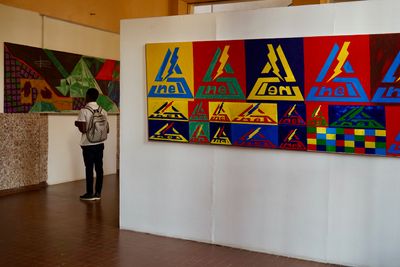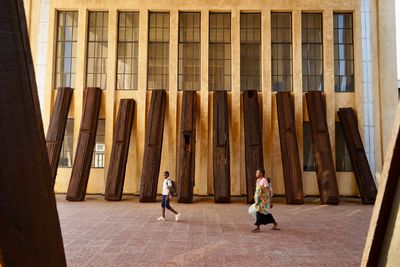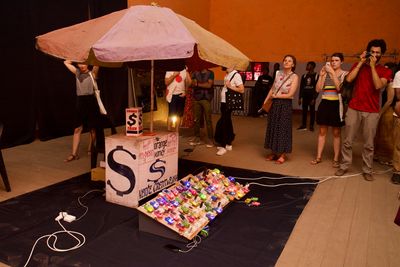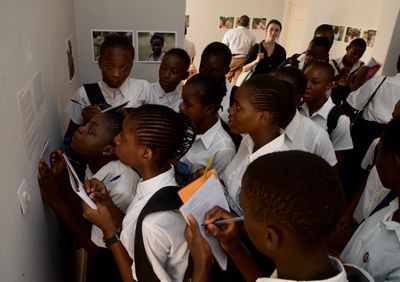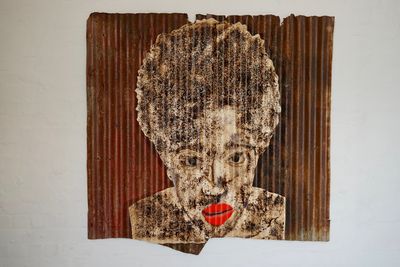Sandrine Colard on the 6th Lubumbashi Biennale
Sandrine Colard. Photo: Julien De Bock.
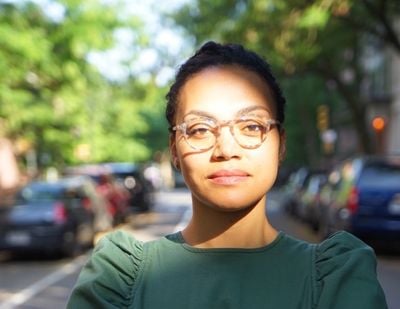
Sandrine Colard. Photo: Julien De Bock.
The Democratic Republic of the Congo (DRC), the largest Francophone nation in Africa with vast resources and nearly 80 million inhabitants, is a place where commodities play a vital role in the national economy and the country's significance on the world stage.
This is the context from which the 6th Lubumbashi Biennale (24 October–24 November 2019) departed, placing the Congo and its material resources at the core of a worldly cartography. As the curatorial statement points out, the Congo shares the largest portion of the equator on the continent, a proximity that sees the sun rise and set quickly over the country: a geographical fact that connects with the possibility for renewal and change that always seems on the horizon here. Hence, the Biennale's exhibition title: Future Genealogies, Tales From The Equatorial Line.
Throughout, artistic director Sandrine Colard simultaneously circumvented and drew on the potency of raw materials—an enduring force and symbol of colonial influence in Congo and beyond—to explore themes of collective identity, imagination, and establishing a gender-based lens approach to theorising post-colonial images of Africa. In her mission to create new languages and reactivate built environments for new artistic encounters, she enlisted various mediums and processes involving herbalism, shamanism, film, storytelling, performance, photography, dance, and more in the works of artists Uriel Orlow, Grace Ndiritu, Sinzo Aanza, Emeka Ogboh, Sammy Baloji, Ibrahim Mahama, Léonard Pongo, Guy Woueté, Dorine Mokha, Pélagie Gbaguidi, among many others.
To write the world from Africa or to write Africa into the world is a compelling and perplexing task. In this conversation, Colard discusses her curatorial approach, which positioned the Congo as a place from which to project the future.
EBThe Biennale explores Africa as a region with a unique position to upend established paradigms. Expanding on the inspiration behind the Biennale's title, Future Genealogies, Tales From The Equatorial Line, could you share how you arrived at the concept for the exhibiton?
SCLubumbashi is a city that I know quite well. My mother is from Lubumbashi, and I spent much time there as a child and later on, when writing my dissertation on the history of photography within the DRC. As I undertook fieldwork for my doctoral research in Lubumbashi, the city began to strike me as a place entrenched in a paradoxical time. Colonial architecture is still extremely present, although the city is changing fast.
The urbanism of the city very much respects the sort of segregation of the colonial period, so that the more well-off people reside in what used to be the white neighbourhood, and other people live within what used to be the 'indigenous' neighbourhood. Then there is also the massive, imposing and iconic slagheap from the mining company, which is reminiscent of the city's past. The present generation is poorly informed about its history. Younger people today know very little about the past.
The soil of the Congo is fertile and indispensable to any form of technology that the world will need for the future. The Congo is a country that is perpetually in the future. All of these different periods coalescing in one city is something I wanted to address. The oxymoron Future Genealogies highlights the impossibility of thinking about the future without looking at the past.
I prefer genealogies instead of histories because genealogies insist on how we are all connected. Today we live in a world of climate change, which binds us, for better or for worse. I wanted to insist that we are in a world that is more connected than ever before. The way we behave in the world has an impact on somewhere else, and this is something that is very vivid in the Congo. Very often, the Congo is at the beginning of the line of a product consumed at the other end of the world. The Congo is a place where the local and the global are perpetually intertwined.
The Congo is a country that is perpetually in the future.
The subtitle, Tales From The Equatorial Line, is as significant for me as the first title. I wanted to think about the Congo in a different way to the tropes associated to it since the big clichés of Joseph Conrad's Heart of Darkness and the big focus on the war in the eastern part of the country. For me, it is essential that we engage the power of the imaginary, to change how we think about a place. I am interested in how we imagine that we can create change.
The Congo sits on the line of the equator. I found this concept very attractive, as it allowed for a different poetry of the Congo. The Congo is defined as the heart of central Africa. Lubumbashi, a province of Katanga, is usually discussed in relation to its mineral resources. I wanted to anchor our thought beyond geographic extraction, in a geographic reality that is also poetic.
EBMost of Africa is often locked into a conversation concerning its futurity, revealing the contrast between what it is and what it could be. The Biennale's accompanying forum offered another arena to dissolve the paradigms of centre and periphery.
Could you shed light on the panel conversation you staged as part of the exhibition, which featured Elizabeth Povinelli, Emmanuel Kasongo Yakusu, Sammy Baloji, Filipa César & Coletivo Cadjigue, Uriel Orlow, Ghislain Ditshekedi, and Filip De Boeck, titled 'Anthropocene, Geo-Capitalism and Indigenous Knowledge'?
SCBeing in Katanga puts you in the cauldron of the question of 'Anthropocene, Geo-Capitalism and Indigenous Knowledge'. It was crucial to involve both Congolese and international scholars to discuss this, while also inviting artists to share a different perspective. With all of these people, we really had a different combination of approaches and artistic interventions responding to environmental questions in consideration of and in collaboration with local communities, organisations, and various forms of indigenous knowledge.
For me, it is essential that we engage the power of the imaginary, to change how we think about a place.
Sammy Baloji shared his work on a new project, which involves developing a colonial research effort that focuses on how the equatorial forest in the Congo will evolve. Uriel Orlow shared his project, Learning from Plants (Artemisia Afra) (2019), for which he grew a garden with a widely unknown plant that can prevent and treat malaria.
Karrabing Film Collective provided a more visual response to the question through a film where, in the not so distant future, Europeans will no longer be able to survive for long periods outdoors in a land and seascape poisoned by capitalism, but indigenous people seem to be able to. The film, The Mermaids, or Aiden in Wonderland (2018) led audiences to consider the future present of climate change, extractive capitalism, and industrial toxicity from indigenous communities. We assembled a variety of responses, and their respective practices and varied presentations of indigenous knowledge allowed for a conversation rooted in the local but with a broadly global expanse.
EBWas it important to your curatorial approach for artists to produce work for the Biennale within the DRC? If so, what were the challenges and opportunities when it came to developing work that responded to the Biennale's theme?
SCYes, however, the logistical challenge of organising an event like this in the Congo can become a valuable asset. Shipping the artworks was challenging, as the postal system in the Congo does not function. Participating artists from outside of the Congo had to go and spend time there and work with local communities on the ground. Sammy Baloji, Ibrahim Mahama, Uriel Orlow, and many other participating artists came to the Congo and developed works and projects, but also gave workshops for local communities and art schools. It was not just an artistic experience; it was a life experience.
It was also important to ensure the Biennale would have a life after its run in Lubumbashi.
EBYou have deployed artists' works from various locations to communicate and translate private, public, and collective memories and histories in a variety of forms and mediums involving sound, taste, and space. What influence do you aim for the Biennale to have on local communities, both within Lubumbashi and across the DRC at large?
SCThe archival exhibition, The Recaptioning Project, was developed in part from my research into the deconstruction of local images of the Congo. A key area of my research into the history of photography focuses on how research is consumed and presented in a place that is not where the research initially took place. The people or subjects of said research barely have any form of return. For me, it was imperative to present this research and exhibition about archival photographs of Lubumbashi, and the Congo more largely, for a Lubumbashi audience; for a Congolese audience.
The Recaptioning Project is a series of diptychs of propaganda images from the Belgian colonial period next to family photographs from the same period from Lubumbashi. An image of pre-1960 the Congo is usually a propaganda image. The Belgian colonial administration vehemently controlled imagery that circulated.
Even today, when somebody wants to talk about the Congo in a historical sense through an image, it is usually through a propaganda image, which is hugely problematic. For me, it was necessary to compare those images with images presenting a different perspective of that period. To do so, Lubumbashi people who had lived through or had descendants who lived through that period recaptioned the propaganda images. They created a new caption underneath the diptychs. The project prompted memories and led to critical intergenerational debates.
EBClaims to truth are critical to the deconstruction of dominant discourses in the history of photography involving the colonial encounter. How might looking at the history of images of Africa through a gender-based lens upend or produce a new association of ideas?
SCThere have been discussions of the agency of women, but there is still a tremendous opportunity to unpack how women in Africa have been discussed or not discussed—this would be an extensive and vital research area. The history of photography in Africa is still rather young, but there is a vast field for the rediscovery of women photographers operating on the continent. I am sure there are many more women whose works we are yet to share.
The work of women has been downplayed, erased, or forgotten and it is exciting to have new figures emerging who offer creative counterpoints and fresh perspectives to the broad framing of the masters or fathers of African photography, such as Seydou Keïta and Malick Sidibé, among others.
EBIt is a powerful act, women photographing women, and we must acknowledge the various relationships, dynamics, or systems at work within these relationships of image-making.
SCYes, the idea that I am pursuing is that I think there was a female photographic gaze in Africa that was born before African women even held cameras. There was a way of posing and self-fashioning themselves that became transposed and materialised when women became photographers. It's something I find fascinating and will continue to develop further as a research area.
We have also given the colonial gaze too much, or more power than it has. Perhaps thinking through this gaze and the demeaning descriptions that accompany specific images blinds us from seeing the power that certain subjects very often retain. We must investigate what they have maintained even in these situations. We have a duty to be authentic to the subject, to further unpack the image and what they have to say.
EBGiven Lubumbashi's long-standing ties with critical exports, it is no surprise that resources would be points of departure for the artists exhibiting in the Biennale. For some of the Biennale's exhibiting artists, commodities are the subject matter of their work; for other artists, commodities serve as the medium. How can artists propose new ways to conceptualise human relations with the earth's natural resources?
SCThe On-Trade-Off project is a large collaborative project that follows the route of lithium. The project raises awareness of the environmental and economic implications of the extraction and processing of lithium, the main raw material needed for the global production of green energy. By recreating a life-size Tesla car, it continues the conversation of following every step of the process of extraction of lithium to the end product—be it lithium in cars or lithium in a cell phone. We remain removed from the exploitation, toil of extraction, manufacturing, and production, and for that reason, this process needed to be made visible.
It was also important to ensure the Biennale would have a life after its run in Lubumbashi. Through Gosette Lubondo's staging of a photography exhibition at a local school, we were able to invite residents and students to rediscover the architectural heritage of the Congo and provide insight into work as a photographer. Another reappropriation effort saw us take an exhibition into an old cinema owned by a mining company.
EBHow did the work of Léonard Pongo add another dimension to Future Genealogies through his view of the Congo?
SCLéonard Pongo has been working on an ongoing series called 'Primordial Earth', which captures Kivu in the eastern part of the country. Pongo has a very poetic approach of capturing a region that is often defined by wars, pillaging, and other forms of violence. The works were situated on an artificial beach by the lake, as a conscious effort to recreate the site of uncontrolled nature. In the series, he explores the incredible forces of life, the earth as a sight of human and ecological violence, and of beauty.
Creating an allegory for the region, Léonard presented the environment as the birthplace of creation and apocalypse, that serves as the eternal place for where nature will always return. —[O]


